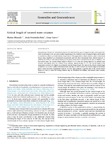Critical Length of Encased Stone Columns

Use este enlace para citar
http://hdl.handle.net/2183/28416
A non ser que se indique outra cousa, a licenza do ítem descríbese como Atribución 4.0 Internacional (CC BY 4.0)
Coleccións
- Investigación (ETSECCP) [826]
Metadatos
Mostrar o rexistro completo do ítemTítulo
Critical Length of Encased Stone ColumnsData
2021Cita bibliográfica
Miranda, M., Fernández-Ruiz, J., Castro, J. (2021). Critical length of encased stone columns. Geotextiles and Geomembranes. 49(5), 1312-1323.
Resumo
[Abstract] Encased stone columns are vertical inclusions in soft soils formed by gravel wrapped usually with a geotextile. Their critical length is the one where further lengthening of the column provides a negligible improvement and it is therefore not effective to build columns longer than it. This paper aims to obtain common values of the critical length using simplified two-dimensional axisymmetric and full three-dimensional finite element analyses. A uniform soft soil layer with a linear elastic perfectly plastic behaviour is considered for the sake of simplicity. For the studied cases, the critical column length is around 1.3–2.5 times the footing diameter for encased stone columns, and slightly lower for ordinary stone columns, namely around 1.1–1.9. The critical length of the encasement is found to be slightly lower than the critical column length. The value of the critical column length is related to the extent of plastic deformation and that may be used to decide the column length in the design phase without the need of parametric analyses. As a first approximation, a general value of the critical column length of 2 and 2.5 times the footing diameter may be considered for ordinary and encased stone columns, respectively.
Palabras chave
Geosynthetics
Geotextiles
Encased stone columns
Critical length
Settlement
Footing
Finite element analyses
Geotextiles
Encased stone columns
Critical length
Settlement
Footing
Finite element analyses
Versión do editor
Dereitos
Atribución 4.0 Internacional (CC BY 4.0)






